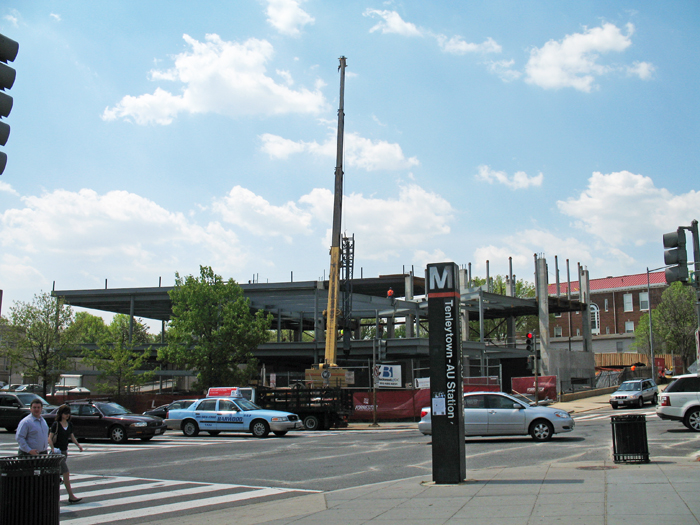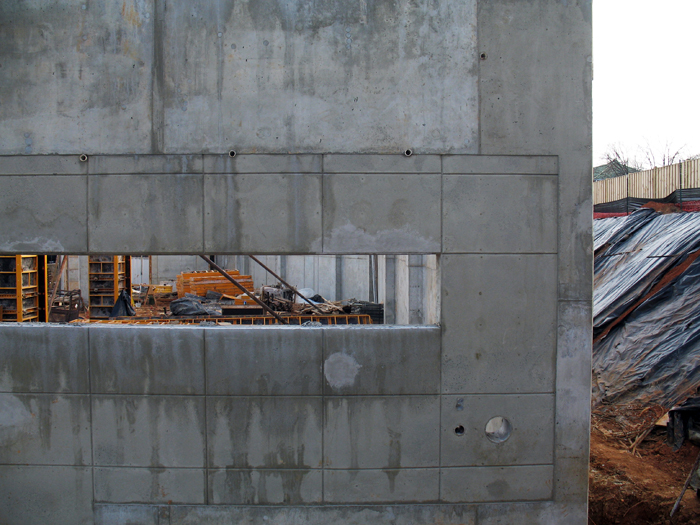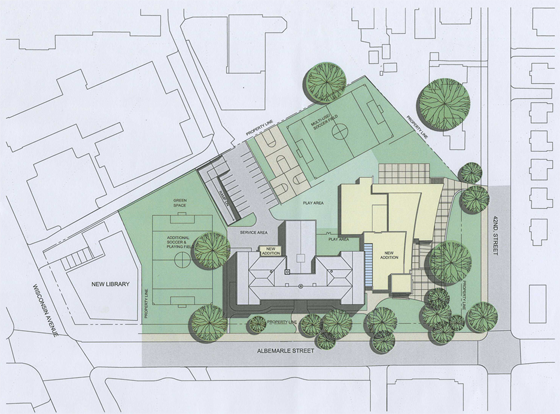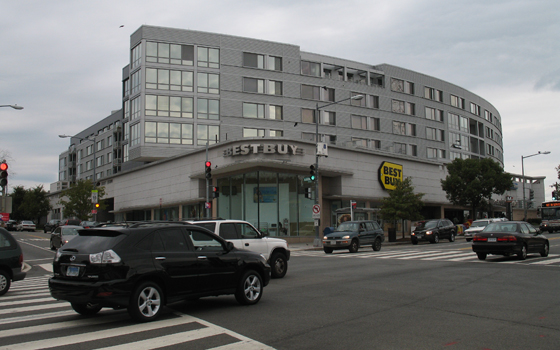This is a long post, so click through…
Tag: janney school
Tenleytown Déjà Vu
As part of a series on things opposed by Tenleytowners, let us discuss the Tenley-Friendship library. Here is a the basic story: a group of opponents, led by Janney parents, protested the loss of critical play space to build a library in Tenleytown and delayed the construction by a few years, until 1959.
Indeed, according to Judith Helm’s monumental history of the area, Tenleytown, D.C.: Country Village into City Neighborhood, when the DCPL began a modernization program for its libraries, they singled out Tenleytown’s inadequate branch. At the time, the Tenleytown library was in a former police substation that was small, dark, and old. But modernity beckoned with its sophisticated information storage technologies, like microfilm. So the downtown overlibrarians decreed from the quietest bowels of their Mt. Vernon Square reading-dome that a new building be built, and that it be built at Albemarle Street.
Their logic was relatively simple, and sounds strangely familiar. The land southwest of Wisconsin Avenue and Albemarle Street was city property with no extant buildings with public transit at its front door. It seemed perfect for the city to use. Unfortunately, in 1955, a playground had already long occupied what was to become the site of 2008’s PPP fight. Even now, the library and the school share the same plat of property (check out this map).
One of the reasons residents opposed the Sears so ferociously in 1940 was that the jungle gym and a few other bits of blacktop stood at the top of a hill right across the street, and perhaps parents feared kids wandering into the new traffic. Then, as now, neighbors worried about auto traffic clogging up the streets, in spite of the streetcars that ran on Wisconsin until 1960. The tactic of throwing the kitchen sink at the project even reared its head.
Some proposed a new library in Fort Reno Park. The park was, after all, close to Murch, Deal, and Wilson, and so better suited to serve all students. That’s amusing because moving the library to the park was tossed around every once in a while in 2009. Both times, this alternative never came to pass. NPS may or may not have wanted to build a parkway through that area. In general, the NPS was as aloof and non-cooperative, just as they can be today.
Then, after five years of folderal, the library opened and people began to forget about the controversy. And here we are again, in 1959.
At top, the third library under construction on April 17, 2010.
North of Tilden: Construction Phases
It’s spring, and that means it’s construction season. Particularly in Tenleytown, a number of big projects have finally started, some after 6 years of delays. The headlines:
- Planning: AU presents their twenty-year plan to ANC 3F meeting. Hilarity ensues.
- Design: Shalom Baranes designing Babes site.
- Approvals: Chevy Chase Park will gain field lights.
- Demolition: If the Van Ness Walgreens is coming in, the gas station has got to go.
- Staging: Fences are up at Wilson.
- Site Preparation: Janney sets up temporary classrooms.
- Foundation: A 4-story condo is going up on Harrison street
- Structure: The Tenley-Friendship Library is no longer a hole.
- Commissioning: The placeholder building at Tenleytown is complete.
- Commercial Fit-out: The 4900 block is getting a pizza place.
And the stories below…
A Look at the Janney Expansion
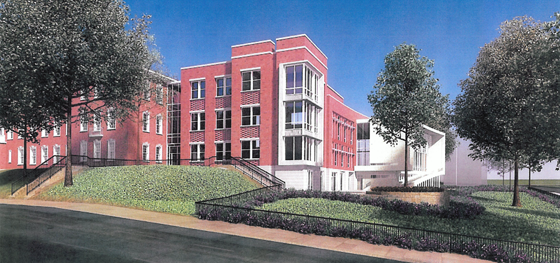
I finally got some images of the proposed Janney School extension. I like it – but it could have been better. With a few objections, I like its conception. Devrouax + Purnell, best known for the Washington Convention Center, the Pepco Building, and Nationals Park, here produced an interesting and attractive school building. However, the location where they have chosen to place the wing results in a lost opportunity for Janney and the community in general. Like too many developers and architects, they approached Tenleytown planning to not upset the status quo. However, any public facility should be designed with an eye to the future – and the current state of Tenleytown cannot last.
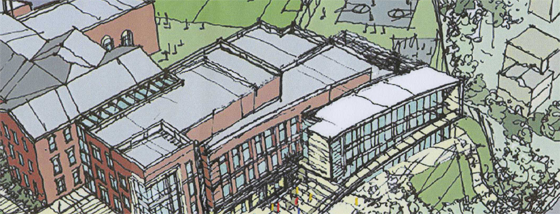
Beginning with the generous setback along 42nd street, the architects attempted to hide the building as much as possible, so as not to intrude on the neighborhood. Although the Albemarle façade extends to the cornice line of the 1923 building, the masses of the building gently diminish into a low white structure that encloses the gym. Moving south along the western face, the building curves gently, from a tower to the first private residence down the block. The architects employed the shape subtly, repeating the curve in each mass to limit its effects. It does successfully integrate into the site.
However, this hesitant approach is not appropriate here. The architects should not have set the building back from the street so much. In doing so, they have reduced the feeling of enclosure afforded by a consistent streetwall, produced an marginally useful green space, and missed an opportunity to relocate the playing field at the center of the Tenley Library Public-Private Partnership debacle.
For the 2007 plan to build a library with several floors of condominiums on top focused on the loss of recreation space (the rightmost field in the image above) for Janney Students. Some of that space would be consumed in the footprint of the condominium structure. However, had the architects located the new wing closer to the property line, they might have opened up space to relocate the eastern soccer field. In a political environment as vicious as Tenleytown’s, a mutually agreeable solution would have been a rare happy ending.
That lost opportunity is my main complaint – but there’s much more review below.
Reno Park Update 091212B: Finding Place
So in the last post, I pointed out that it was easiest to demonstrate that some location is a place by showing the density of people there. That’s what this map is. It’s an imprecise but useful tool to map and note the actual behaviors of pedestrians in the T-T area. I’ve made a point of making it blurry and gradated. There are not borders, so much as dips in circulation and public activity that result from the popularity of one area and the amount of effort pedestrians are willing to exert to get from one place to another.
Take, for example, Friendship Heights. Most people arrive by Metro or driving to the retail district. But within only two or blocks of that hub of activity, the circulation patterns change: there are fewer people and they are generally more local. The walkable distance matters more. It’s clear that the locality ends, even if it is slight and gradual.
The character of the architecture changes slightly as one travels south on Wisconsin. It’s shorter, somewhat dinkier. But at Fessenden Street, the entire block is suddenly small, two-story local retail. It looks like little to the north, but also seems slightly different from Tenleytown, up a steep hill to the south. Someone who lived a block to the south would feel like it might be part of Tenleytown, and someone who lives a block to the north might feel it’s Friendship Heights. This is hard to define; just like foot traffic, it comes in gradients. However, due to its higher pedestrian traffic, small public park, and consistent look, I would argue it is effectively a between-place. So let me show you what I’ve come up with:
Reno Park Update 091128: ANC Analysis
If we compare the other legal structures to the ANC geography, some other interesting trends come to light. Take the elementary schools, for example:
Reno Park Update 091004A: Schools
So, in addition to the visible boundaries of the city, there are the invisible ones, ones that are really only legible to a bureaucracy, but have significant effects on the lives of residents. Because it affects individuals so young and even effects the parents, where someone goes to school seriously alters the social geography of cities. They decide where the majority of socialization occurs: in one school, in another school; in private schools, in public schools; in classrooms or in breakfast nooks.
When I was a wee little Flannie, attending Murch and carousing about my block, I had neighbors across the street whom I hardly knew. Why? They went to Janney. We met and played outside occasionally, but by 3rd grade, we both had already formed our social lives, and that was it. Our parents were likewise divided; they knew each other, but that was it. My street was the boundary between two schools and there was a palpable difference between the facing blocks.
In the Reno-Tenleytown-Tobago area, there are seven schools that provide Nursery school through Twelfth Grade education. Obviously, there’s also American University, but that’s not as relevant since its students are not shaped as much by boundaries and divisions. There are also any number of private and parochial schools students could attend, three of which are in the area, but with a minivan or a Volvo, you too can idle your car outside your child’s school. So let’s just do the public schools.
Stop the Mega Sears!
Most residents and visitors admire the sleek moderne building that now houses a Best Buy and a Container Store. It is a registered landmark, ably capped by a Shalom Baranes-designed condominium. Critics and writers have shown almost nothing but praise for the structure, including Roger Lewis.
But in 1940, when Sears Roebuck first proposed the store, the neighborhood condemned the proposal and tried to stop Sears with all the weapons they had. Letters were written to Eleanor Roosevelt, lawsuits were filed, and many cried out for someone to think of the children. The primary concerns revolved around the Janney School, just as they have with the Library PPP and also in another dispute in 1991 about a homeless shelter.
North of Tilden: Old wounds

I. The city has declared that they will begin construction of the new Freelon-Group-designed library in September. However, out on the Tenleytown Listserv, discussion flared up when it became clear that the department of economic development was asking the architect to add structural columns that could support multistory residential. This practice is not uncommon, but it would be a wasteful expenditure if the Tenleytown Historical Society succeeds in landmarking the school, and adding to the structure becomes more difficult. Both properties sit on the same lot.
II. The HPRB has agreed to review a preservation application for the 1925 elementary school. Built by the city architect, Albert Harris, it’s a decent example of the stripped-down Beaux-arts Georgian style he developed for the rapid expansion of public facilities in the early 20th Century. Although it was the first of all the schools built in the area, I don’t see how the 84-year-old school merits perpetual legal protection, at least not at this point. Especially considering that the building is not in any danger of demolition or permanent alteration. Moreover, landmarking could seriously delay the much-needed renovation of the aging school needlessly.
III. The department of education is proceeding, however, with the development. They’ve hired Devrouax + Purnell to design a wing to the west of the current building. Part of the planning framework requires that DP respect the historical structures of the area. I have no doubt that they will. Their work in DC has been humane and sensitive, while also adding innovating modern elements. Freelon and DP’s buildings will be coups for the architecturally stagnated area, so it’s in the neighborhood’s interest to support their work.
IV: On the site of the former Oakcrest School at 4101 Yuma Street, a new religious center for women and girls will be opening this fall. The Yuma Study Center, a vaguely defined but Opus-Dei-affiliated religious institution will itself be renovating and expanding the old Bon Secours covenant. The current structure is dilapidated, so renovation will be welcome, once I can figure out exactly what the institution does.
Van Ness: This past weekend saw the second-ever farmers’ market on the plaza in front of UDC. The market is a twofer fer the residents of condograd across the street, putting the large plaza to use and getting farm-fresh goods onto a public street.
Hawthorne: The Post covers the ongoing slapfest in the very northern neighborhood of Hawthorne, a small collection of 1950s houses that was built in the fashion of the times: without sidewalks. DC has been improving and adding sidewalks throughout the city, improving pedestrian safety and encouraging walking, however, some residents of the area northeast of Utah Avenue won’t have any of that filthy urban nonsense. They moved there because they wanted to be in DC without being in the city.
What, they stayed in DC for the schools? Or for the lack of voting rights?
The arguments against sidewalks sort of tumble out of opponent’s mouths, with all kinds of illogic. This is like country in the city, yes, and a ranch house makes your .2 acre lot a ranch. Nobody walks around here, uh, ever wonder why? We need curbs, not sidewalks, so pedestrians can’t get out of the way of cars? Lastly, the venerable, but that’s the way it’s always been! makes its appearance, proving opponents to be examples of a certain five-letter acronym. You can hear how literally incoherent their arguments are in this video.
On the other hand, there are almost as many proponents, since many residents do see the public obligation to make the streets safe and accessible for all modes of traffic. It’s heartening to see proponents of reasonable growth out and advocating their position. There’s not much of a worry that Hawthorne will become infected with the dread contagion of urbanism, since it’s pretty far from any sort of rapid transit and unsuitable for larger growth. It’s always going to be a side neighborhood, one whose character will not be negatively altered by allowing people to walk comfortably around their neighborhood.
